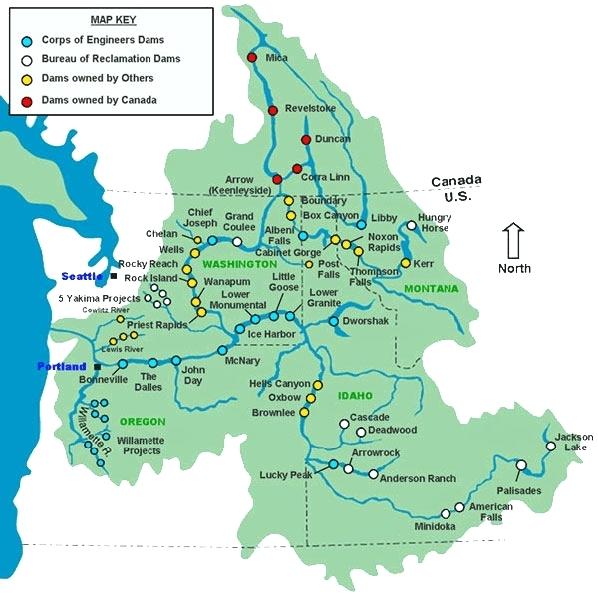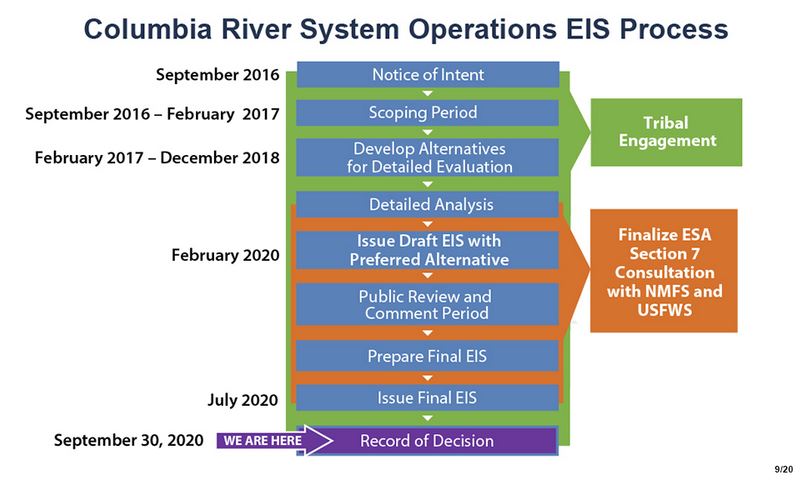Columbia Snake River System
Powering our economy and benefiting our environment.
The Columbia-Snake River System is part of our nation’s “Marine Highway” designated as The Inland Marine Transportation System, managed by the U.S. Army Corps of Engineers. Together the inland and coastal waterways handle one-sixth of the nation’s industrial materials, commodities and products. The Port of Lewiston, strategically located, is at the furthest end of the Columbia-Snake River system, 465 river miles inland, and offers an equitable, alternative route for destinations into Canada and the U.S. Midwest.
Learn More About America's Marine Highway
Clean, Renewable Hydropower
The Snake River dams alone provide enough carbon-free energy every year to power a city the size of Seattle and integrate wind and solar renewables.
There are eight dams and navigation locks on the Columbia-Snake River System; four on the Columbia River and four on the Snake River. These navigation locks permit vessels to pass from one water level to another as they proceed up or downstream between Portland/Vancouver and Lewiston, Idaho. The vertical lift of the rivers between these two points is 730 feet. The standard size lock in the system in 86 feet wide and 675 feet long. The river channel is a minimum of 14 feet deep. Loaded barges average 10 feet of draft, while tugs draft between 11 and 12 feet.
This route is a viable alternative for logistics companies representing companies who have oversize equipment destined for the interiors of Canada and the U.S. Midwest. The carbon footprint, transportation, permitting and strategic planning costs of utilizing this route is significantly less than shipping through alternate marine routes importing into the United States with the same destination. For route and permitting information, visit Idaho Transportation Department website.
Efficient Transportation
- Moves Millions of Tony of Cargo Annually
- Major Export Gateway in the U.S.
- Reducing Carbon Emissions (4 Barge Tow = 140 Rail Cards = 538 Trucks)
Diverse Recreation
The Columbia Snake River System supports water recreation and tourism: cruise ships, boating, fishing, jet skiing, paddle boarding, kayaking, parks, walking trails, public docks, camping opportunities and swimming destinations.
Environmental Impact
Advanced fish passage-systems help ensure high salmon survival at the dams. Federal agencies in charge of Columbia River System Operations are in the process of preparing an Environmental Impact Statement (EIS) for the system. Public comment for the scoping period closed on Feb. 7, 2017. The agencies are now working to draft the EIS, a process that is expected to take a few years. The Port of Lewiston will provide updates as the process moves forward and provide notice when the draft EIS is available for review and comment. View the latest CRSO Newsletter (Winter 2018).
Additional information about the EIS process, river system and salmon recovery:
- Pacific Northwest Waterways Association Fact Sheet
- Northwest River Partners Background Information News Release
- Port of Lewiston Salmon Recovery Fact Page
- Learn more about the Snake River Dams - snakeriverdams.com
Thank you to everyone who joined us in providing comments and questions during the scoping process. Alternatives considered for long-term river system operations could greatly impact our region, as we depend on the river for so many things – power generation, importing and exporting cargo, recreation, flood risk management, salmon recovery and more. It was imperative that your voice was heard in this process. Now, many important questions and concerns will be addressed, thanks to your participation by the Feb. 7 deadline.
- Read comments submitted by the Port of Lewiston
- Learn More - Columbia River System Operations Home Page
- View informational materials presented at EIS public scoping meetings
The EIS process was a directive from the latest court ruling in the ongoing debate about how best to balance the many benefits of the river system with the impacts to salmon and steelhead species protected under the Endangered Species Act. In 2016, Judge Michael Simon of the U.S. District Court for Oregon required the EIS and suggested it should include evaluation of alternatives like breaching mainstem dams throughout the system. The Port of Lewiston and many others believe that recent record returns demonstrate that salmon and dams can successfully co-exist.
Helpful Links
- Columbia Snake River System EIS
- The Snake River Dams: Analysis of Cost Claims, CEDER/Dennis Wagner
- Impacts of Channel Deepening on Columbia River, EcoNorthwest
- Snake River Dams website
- Northwest River Partners Fast Facts on Columbia River Basin Benefits
- Pacific Northwest Waterways Association, Columbia Snake River System Fact Sheets
- US Army Corps of Engineers - Walla Walla District
- US Army Corps of Engineers - Portland District


